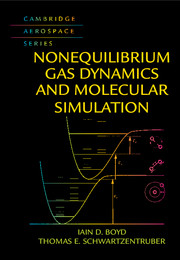Book contents
- Frontmatter
- Contents
- List of Illustrations
- List of Tables
- Preface
- Acknowledgments
- Part I Theory
- 1 Kinetic Theory
- 2 Quantum Mechanics
- 3 Statistical Mechanics
- 4 Finite-Rate Processes
- Part II Numerical Simulation
- Appendix A Generating Particle Properties
- Appendix B Collisional Quantities
- Appendix C Determining Post-Collision Velocities
- Appendix D Macroscopic Properties
- Appendix E Common Integrals
- References
- Index
1 - Kinetic Theory
from Part I - Theory
Published online by Cambridge University Press: 13 April 2017
- Frontmatter
- Contents
- List of Illustrations
- List of Tables
- Preface
- Acknowledgments
- Part I Theory
- 1 Kinetic Theory
- 2 Quantum Mechanics
- 3 Statistical Mechanics
- 4 Finite-Rate Processes
- Part II Numerical Simulation
- Appendix A Generating Particle Properties
- Appendix B Collisional Quantities
- Appendix C Determining Post-Collision Velocities
- Appendix D Macroscopic Properties
- Appendix E Common Integrals
- References
- Index
Summary
Introduction
The primary aim of kinetic theory is to relate molecular level behavior to macroscopic gas dynamics. This is achieved by consideration of the behavior of individual particles, and integrating their collective properties up to the macroscopic level. Consider the simple case of a gas at rest as illustrated in Fig. 1.1. At the macroscopic level, this is an uninteresting situation because all the gas properties, such as density (ρ), pressure (p), and temperature (T), are constants. However, at the molecular level, there is a great deal of activity with particles traveling individually at relatively high speed, and undergoing collisions with other particles. When one considers the behavior of particles at the molecular level, they really only undergo two processes: translational motion in space due to their velocity, and intermolecular collisions with other particles in the gas. While kinetic theory analysis has to consider these two physical phenomena, we will see that it is a complex process. For example, the motions of particles will be divided into consideration of bulk, directed motion, and random, thermalmotion. Collisions of particles involve a nonlinear process that includes elastic events where only the particle velocities change, and inelastic processes involving energy exchange with internal modes and even chemical reactions.
Fundamental Concepts
In this section, we first provide an introduction to some basic concepts and definitions that will be needed to achieve our goal of relating molecular behavior to macroscopic gas dynamics. We then employ these concepts later in the chapter to analyze a number of different gas flow situations.
Particle Model
The particle is the fundamental unit in kinetic theory and we will use this term generically to refer to atoms and molecules. Each particle has the following properties:
• Mass (typically around 10-26 to 10-25 kg)
• Size (typically a few 10-10 m)
• Position, velocity, and internal energy
The mass of a particle is simply the sum of the masses of its constituent atoms. Position is the center of mass location of the constituent atoms and velocity is the center-of-mass velocity of those atoms. For molecules, atomic motion relative to the center of mass (i.e., rotation and vibration) contributes to the internal energy of the particle.
- Type
- Chapter
- Information
- Nonequilibrium Gas Dynamics and Molecular Simulation , pp. 3 - 53Publisher: Cambridge University PressPrint publication year: 2017
- 1
- Cited by



